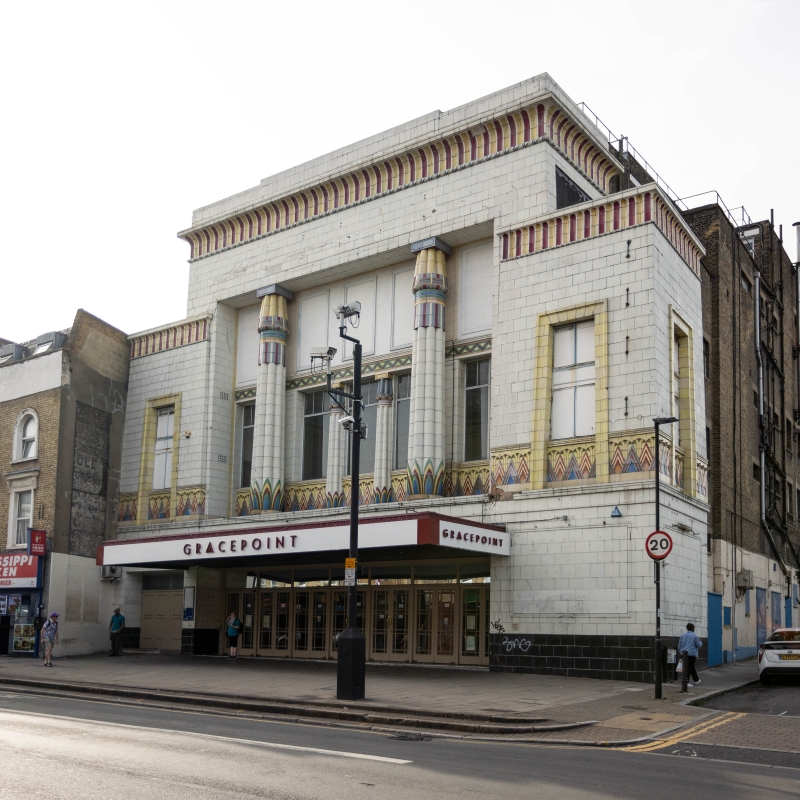- by Nigel Smith
- 9 May 2024
This 1913 advert from The Kilburn Times Hampstead and North-Western Press tells us a lot about cinemagoing in London before World War I.
The Maida Vale Palace really was one of ‘London’s Most Luxurious Picture Theatres’ described at its opening in the local paper as “undoubtedly the last word in buildings of this kind” with 1,500 seats, marble floors and stairs between mahogany wall panels.
The ‘magnificent orchestra’ included “a skilled organist, a pianist, three violinists, one cellist, and one clarinet”. And while your local cinema won’t accept booking by letter anymore there was a precursor to today’s various membership schemes going on back then – you could essentially buy 12 tickets in advance for the price of 10.
"Not pictures, but realities"
But what really catches my eye here is the promotion of Kinemacolor. Kinemacolor was the world’s first successful colour film process. Invented in 1906 by George Albert Smith (also a hypnotist, psychic and magic lantern lecturer) it grew commercially two years later once the American-born producer Charles Urban backed it and distributed the films from his Wardour Street HQ.
Moving pictures themselves weren’t yet a decade old when Urban’s Natural Colour Kinematograph Company began marketing their shorts as “not pictures, but realities.”
How did the process work?
Kinemacolor used standard back-and-white film but its images were shot through alternating green and red filters. When projected back through spinning green and red discs they created the illusion of a colour image.
Luke McKernan, who’s written a book about Charles Urban, took these photos of an original Kinemacolor projector when it was used for a demonstration in 2008. You can clearly see the original, spinning filter.
This clip shows what the process might have looked like.
You’ll also find one of the Natural Kinematograph Company’s cameras in the Science Museum’s collection.
Delving into the catalogue
We don’t know what specific films were shown at the Maida Vale Palace but the Internet Archive has a copy of the company’s 1912 catalogue which lists hundreds of titles that might have been available. The shorts lasted about 5 minutes each with such titles as Two Chorus Girls (“episodes of life in the theatrical world are admirably presented by Kinemacolor in this very interesting dramatic subject”) and The Burglar as Father Christmas (“the story is a pathetic one, well told, admirably staged and beautifully portrayed”)
You can browse through the catalogue here.
Around a thousand Kinemacolor films were produced between 1908 and 1917 but like the majority of silent era films very few survive. Luke McKernan suggests that when Charles Urban’s parent company went bust in 1924 most of the Kinemacolor library was probably destroyed because it now lacked commercial value. Remarkably, a cache was discovered in Italy a few years ago which the Cineteca di Bologna restored and issued on DVD.
Post-script: The Scala Theatre
You’ll notice that the advert says the Palace is showing films “from the Scala Theatre”. The Scala opened in 1905, expanding from an earlier theatre by architect Frank Verity.
Between 1911 and 1915 Charles Urban ran it as the showcase location for his Kinemacolor films. Its pop culture credentials were burnished further in 1964 when the Beatles used the theatre for the climatic concert scenes in their first film A Hard Day’s Night.
In 1969 the theatre was demolished to make way for offices – Scala House. Between 1978 and 1980 the ‘original’ Scala Cinema operated in the basement here before moving to King’s Cross in 1981. But that is, very much, another story…
Further Exploration
- Discovering KinemacolorArticle by Luke McKernan
- Kinemacolor: dazzling colour film frames from more than 100 years agoArticle by Bryony Dixon on BFI website
- Timeline of Historical Film ColorsA deepdive on Kinemacolor
More stories:

21 February 1896
The birth of cinema-going in Britain
The first public screenings of the Lumière brothers’ films change entertainment forever.
Regent Street Cinema (1912 —)








Leave a comment